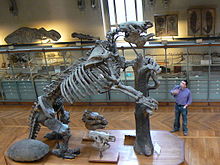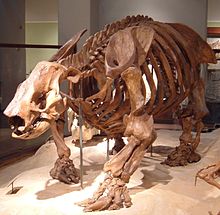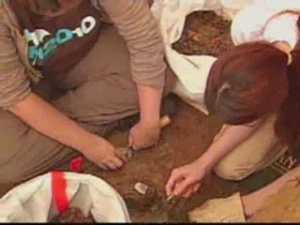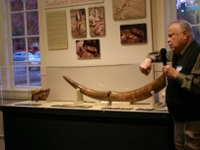The Book of Mormon says there were elephants in the Land Northward:
And they also had horses, and asses, and there were elephants and cureloms and cumoms all of which were useful unto man, and more especially the elephants and cureloms and cumoms. (Ether 9:19)
One can’t help but wonder if part of the usefulness of the elephant, curelom, and cumom was for logging:
10 And it came to pass as timber was exceedingly scarce in the land northward they did send forth much by the way of shipping.
11 And thus they did enable the people in the land northward that they might build many cities both of wood and of cement. (Helaman 3)
Were there elephants in the Irondequoit Bay area? Yes there were. On display at the Rochester Museum & Science Center are two full sized Mastodons that were dug up right there in Rochester:
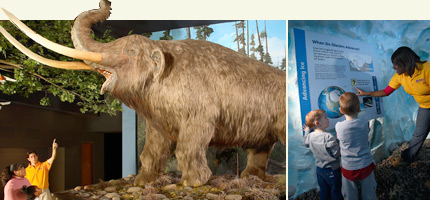
The objection some may have with placing Mastodons during Book of Mormon times is with the dating of their existence. Believers should have discovered that much of scientific dating has been skewed to reflect a framework supporting evolution. Once a person understands that, these objections quickly disappear. See also New Mastodon Discovery in Western New York.
We encourage readers to get up to speed with the debate on Creationism verses Evolution. Creationists scientists have blown such large holes in the evolutionary framework, it is a wonder anyone exclusively believes it anymore. Dr. Carl Baugh of Creation Evidence Museum is a good place to start. Make sure you visit his “Museum Displays” page for startling evidence supporting creation and an entirely different dating system.
The dinosaur discovery that shocked the world!
“…they did fight like dragons” (Mosiah 20:11, Alma 43:44)
*”Geologist claims a few dinosaurs survived extinction event,” The Washington Post, 1/29/11
Live germs and fresh meat vs. deep time
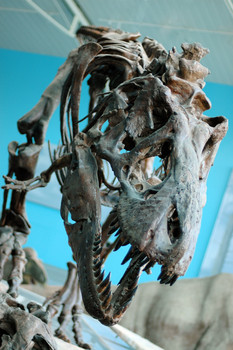
“The bedrock assumption of the evolutionary or “old earth” paradigm is that the fossil record is a record of “deep time,” lasting billions of years. Neither live germs nor fresh meat should last that long. Yet investigators have found both. (Terry Hurlbut, “Live germs and fresh meat vs. deep time- National Creationism,” Examiner.com, February 7th, 2011 )
The point is, don’t let skewed theories prevent you from accepting the truth of the scriptures. Be sure to visit the newly opened 60,000 square foot, $27 million dollar Creation Museum in Petersburg Kentucky for more evidences.
Cureloms & Cumoms
We discovered the identity of Cureloms and Cumoms serendipitously. Firstly we found evidence that Lamanites co-existed with Mastodons (i.e. elephants), then we discovered that Mastodons co-existed with Ground Sloths, the genus Megatherium and Paramylodon harlani in particular were well suited for heavy pushing, pulling and carrying.
Curelom
Cumom
“Tar pits reveal evidence of huge mastodons and two-tonne, armour-plated sloths.” (BBC)
Sea-Tac International Airport – February 13, 1961
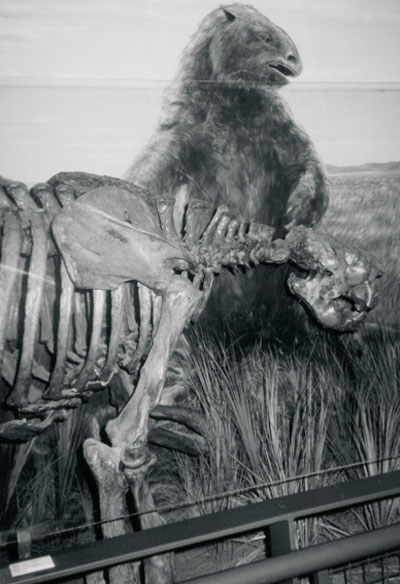
“…on February 13, 1961, workmen discovered the bones of an Ice Age sloth near the north end of Sea-Tac International Airport. The sloth was about 12 feet long. The animal was a relative of the present South American tree sloth. Radiocarbon dating of the peat in which the skeleton was found established the sloth to be about 12,500 years old.” (Scott Schaefer, “Happy Valentine’s Day: 50 Years Ago, Giant Sloth Remains Unearthed Nearby,” The B-Town Blog, 2/14/11)
Sloth Central

Harlan’s ground sloth was the second largest of North America’s four Ice Age ground sloth species, weighing in at approximately 3,070 lbs.–about 20% more than Jefferson’s sloth (McDonald, 2005). P. harlani was a grazer, or perhaps more properly a browser-grazer (Naples, 1989) and widespread on North America’s grasslands. M. jeffersonii is believed to have been a browser. . . . Dave (Fourth Sloth Discovered, May 8, 2009)
Mastodon Discoveries
A journey through prehistoric Bloomington (Indiana) – 1/27/11
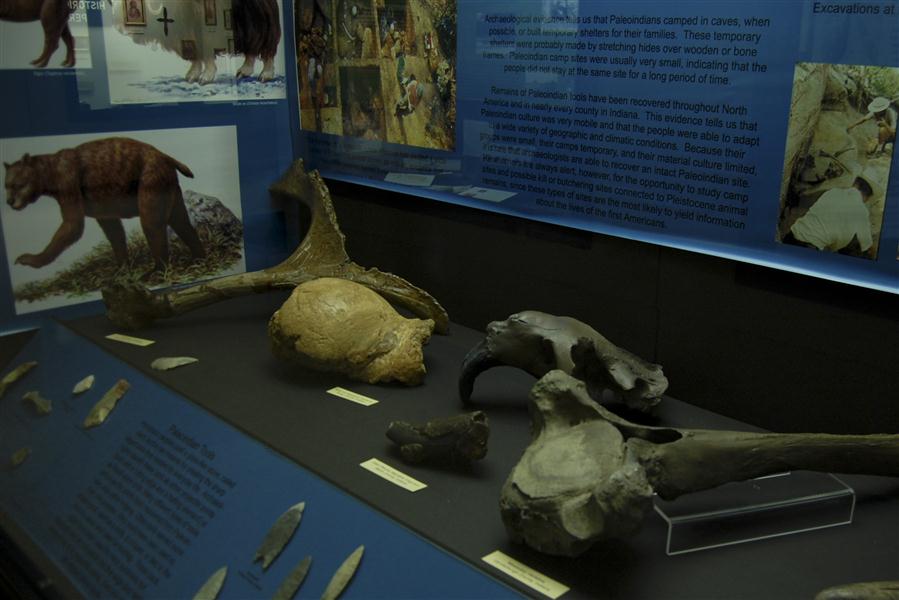
“One of these warm cycles gave Bloomington a partially tropical environment, Polly said. This environment had some shallow seas which made the limestone quarries that still exist now.”
“Because of this change in environment, Polly said, Indiana has seen many interesting big animals, such as the American mastodon, the muskox, the mammoth, the giant beaver, the dire wolf, the ancient bison, the saber-toothed cat, the giant ground sloth, the Pleistocene jaguar and the Pleistocene horse.”
“’We know the human groups ate mammoth and mastodon because we see their tool cut marks on the fossils,’ Herrmann said.
With the changes in climate and increasing number of hunters, many of the large animals such as the American mastodon went extinct, Herrmann said.” (Isabel Dieppa, “A journey through prehistoric Bloomington,” Indiana Daily Student, 1/27/11 )
Mastodon, Mammoths, Sloths Found – 10/29/10

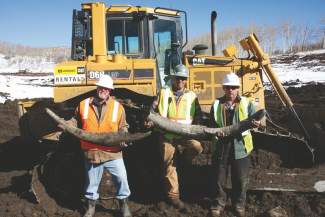
“Striking evidence, on display at the Snowmass Water and Sanitation District’s office, that two species of ancient creatures have been found in Ziegler Reservoir. On the left is a tooth from a mastodon, which ate branches, twigs and roots. On the right, the tooth of a Columbian mammoth, which ate grass. The mastodon tooth was found Thursday at the excavation site by construction workers removing soil in a layer of silt, about 10 feet below where the mammoth tooth was found.”
“’Mastodons are very rare in Colorado, so that makes it very exciting,’ said Laura Holtman, the director of public relations for the Denver museum.
The mastodon tooth is thought to be anywhere from 100,000 to 1.5 million years old and is a smaller, stockier and much older species than mammoths, which apparently last roamed around what is now Snowmass Village about 10,000 years ago.”
“Mammoths were mainly plains animals that grazed on grass, which is one reason why finding them at 8,850 feet is unusual. In fact, the Snowmass mammoths are at a higher elevation than any others found in the U.S.” (Brent Gardner-Smith, “Mastodon, more mammoths found,” Aspen Daily News, October 29, 2010; See also Madeleine Osberger, “Mammoth or mastodon? Either way it’s amazing. Remains of four more extinct animals found,” Post Independent Glenwood Springs, 10/29/10; Scientists uncover entire Ice Age ecosystem after unearthing wealth of bones, 11/6/10)
Evolutionism fails again, now over Mastodon hunters! Yet so few know! – 10/24/10
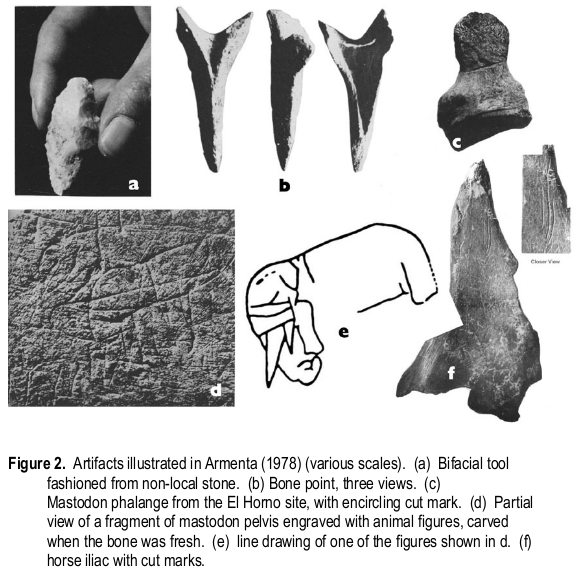
HERESY IN THE CAMP: HUEYÁTLACO, A 250,000 YEAR OLD MASTODON-HUNTER SITE FROM CENTRAL MEXICO AND ITS TREATMENT BY DARWINISM IN LATE 20TH CENTURY USA (The Paradise Post,10/24/10)
Smithsonian does not dispute authenticity of archaeological find in Vero Beach – 10/20/10

“The Smithsonian Institution in Washington, D.C., has found no reason to dispute the authenticity of an one-of-a-kind archaeological discovery that might help confirm a human presence here up to 13,000 years ago at the end of the last Ice Age.
In early 2009, local fossil collector James Kennedy cleaned off an old bone he found two years earlier and noticed some lines on it — lines that turned out to be a clear etching of a walking mammoth with tusks.”
“It is presumed to be the oldest known art object of its type found in the New World, said Richard Hulbert, a paleontologist with the Florida Museum of Natural History, Gainesville.
The person who created the etching, presumably with a shark tooth or flint implement, had to have seen a live animal to have drawn it in such detail, he said.” (Elliott Jones, “Smithsonian does not dispute authenticity of archaeological find in Vero Beach,” TCPalm, 10/20/10)
Bones = buried treasure in TN backyard – 10/20/10
“Mastodons are prehistoric, elephant-like creatures, believed to have weighed up to 12,000 pounds. But bones aren’t the only thing the team has found. They also discovered what appear to be tools belonging to prehistoric humans.” (Source)
Also among the bones were flakes of stone scored to make a tool of some kind likely made by hunters. It was here near the end of the last Ice Age, that a pond existed that drew animals, including a mastodon, which probably was killed here by hunters, Deter-Wolf said. If the bones prove to be a mastodon’s, it adds more importance to land that has twice yielded archaeological treasures. Archaeologists found several bones along a stream near the site in 1977. Then, in 1994, archaeologists unearthed mastodon bones and more than 30 stone tools nearby. (Kevin Walters, “Bones unearthed yard may be those of mastodon,” The Tennessean, 10/20/2010)
William J. Thibodeaux – 9/19/10
“According to an article written some time back by Mario Mamalakis (Lafayette Advertiser Centennial Edition, April 22, 1984, p. 6), there was much excitement in Lafayette in the early 1950s when an excavation crew discovered some large bones. At the time, Dr. Louis Gimbrede, USL professor and head of the geology department, along with Professor William Payne, identified the fragments as those of a “mammut” or mastodon bones. Radiocarbon dating of the teeth and bones indicated the animal died about 12,000 years ago.”
“The animals ceased to exist some 8,000 years ago. However, despite of the official extinction date, records from Cabeza de Vaca’s cruise along the Gulf coast in the early 16th century reports that Indians, probably Attakapas, were at the time hunting some huge mammal, probably the last remnant of the now extinct mammoth or mastodon.”
Atchafalaya Voices, Digging Up Bones by William J. Thibodeaux
Drew Gentry – 9/7/10

“The skull of a mastodon-like animal was unearthed in recent weeks in a dirt mining pit near Mesquite, certainly not an everyday occurrence.”
“Houde cited the example of a spectacular ground sloth skeleton, with bits of hair and skin left, that was found in Aden Crater west of Las Cruces in the late ’20s or early ’30s. The specimen is now housed in the Peabody Museum in New Haven, Conn.”
Paleontology: Science matched with patience by Paul Huggins Staff Writer
Prehistoric Fossils Found in Tennessee Backyard 4/10/10
“Leyden said he was shocked to learn that fossils, which one expert says could be anywhere from 30,000 years old to 2 million years old, were buried on his property. ‘I grew up in New Jersey. I might find a body, but not a prehistoric animal.‘” (Michelle Ruiz, “Prehistoric Fossils Found in Tennessee Backyard,” AolNews, July 4, 2010)
Gary & Gleen Keeton – 2008

“This was the first scientifically excavated mastodon recovery site in Orange County, which has the more mastodon bones recovered than any other region in the world.
One tusk was missing a large portion, having been eroded by the river. The other was recovered complete, and at 9-and-a-half feet, is the second largest tusk found in New York State.” (Norma Stoddard, “Program delivers audience to the age of mastodons,” Straus Newspapers, 1/27/11; Also: Melissa Stutz, “Unearthing Orange County’s mastodon tusks,” Times Herald-Record, 1/31/11 )
Ralph Bishop – 7/30/07

“Mastodon bones found in Nipomo and carbon-dated to approximately 20,000 years ago will be on display when the Orcutt Mineral Society’s annual Rainbow of Gems Show returns to Nipomo.
Ralph Bishop, a lifelong Santa Maria resident, began unearthing the bones more than a decade ago at a location he will identify only as “Secret Canyon.”
What makes the find unusual is that the bones were found with stone implements indicating the animal was either killed or, at least, butchered by early Native Americans, Bishop said.
One stone implement found at the site matches V-shaped cracks in a leg bone, showing the stone was likely used to break open the bone to reach the nutrient-rich marrow inside.
He also found burnt stones at the site, indicating the possibility of a fire ring.“
“The mastodon bones aren’t the only ones Bishop has found at the site. He’s also found the bones of horses, mammoths, giant ground sloths, huge bison and the largest cat that ever lived.”
Discovery Channel – Mastodon in Your Backyard – October 2001
Mastodon In Your Backyard– The Ultimate Guide – Learn how the mastodon evolved, migrated out of Africa, and survived in the North American forests for roughly 3.7 million years and dozens of climate changes. Explore the controversy among theories explaining how and why this species disappeared. Airs on the Discovery Channel on October 7 at 9 PM and 1AM, October 14 at 7PM, October 17 at 9PM and 1AM and October 20 at 6:00 PM, ET.
Robert Moffett – North Java, NY – 2000

Scientists from the Paleontological Research Institution (PRI) and Cornell University are recovering the bones of a mastodon from a pond in rural Wyoming County, between Rochester and Buffalo. The bones were found by Robert Moffett of North Java, NY when he had a fishing pond dug on his property more than a year ago. (“New Mastodon Discovery in Western New York,” Paleontological Research Institution)
On the right is the pond, from where this dirt was dredged. It is possible, but not very likely, that some bones still remain at the bottom of this pond. On a clear day, the city of Buffalo, 40 miles to the west, is visible in the distance. (“Digsite at North Java, New York, Museum of the Earth, PRI)
1999 Larry Lozier – Hyde Park, New York


In August of 1999 Larry Lozier hired an excavator to deepen the pond in the backyard of his home in suburban Hyde Park, New York…95% of the bones were recovered, including both tusks, the skull and all major limb bones…There is a chance that Native Americans laid eyes on this animal when he was alive, though there is no evidence to indicate that humans had any direct impact on its death. (“The Hyde Park Mastodon Fact Sheet,” Paleontological Research Institution )
1999 Gilbert Mastodon – Chemung County

The Gilbert Mastodon was found on September 11,1999. The mastodon was unearthed when a pond was being excavated in Chemung County. The site was a pond and boggy area located in a glacial valley. (Gilbert Mastodon, Cornell University)
Stan Johnson 1990’s
“Mammoths, which are now extinct, were large elephants from the Pleistocene era and were typically hairy with a sloped back and long, curved tusks.
Peyton said both mammoths and mastodons, described as elephant-like mammals, roamed North America during the Pleistocene era which was two million to 12,000 years ago.
“It’s believed that both were hunted to extinction and lived as late as 4,000 years ago, which means they were present in the Holocene era which is today or modern time,” Peyton explained, noting that the mastodon is much older and lived as long ago as 20 million years.
Johnson guessed that the largest tooth, which is a yellowish color, weighs over 12 pounds.”
“Finder of ancient elephant teeth,” Elizabeth Barrett, Gothenburg Times Online, September 30, 2010
Valley of the Mastodons – Hemet California – 1993

“One of the biggest finds was made in 1993 at the Diamond Valley Lake reservoir outside of Hemet, California.
It yielded numerous remains and led to the site being nicknamed the “Valley of the Mastodons”.
Current excavations are going on annually at the Hiscock Site in Byron, New York.
In July 2007, the longest mastodon tusks in the world – measuring 16ft and each weighing a ton – were discovered in Milia, north of Athens.” (Daily Mail Reporter, “Builders unearth 2 million-year-old skull and tusks of elephant’s ancient relative,” Mail Online, 25th March 2011)
Russell W. Graham 1979
“In 1979, paleontologist Russell W. Graham of the Illinois State Museum provided the first solid evidence of the coexistence of humans and mastodons, as a stone “Clovis” type projectile point was found in association with mastodon bones. This was the first site in eastern North America where this association was conclusively demonstrated.”
Manis Mastodon – 1977

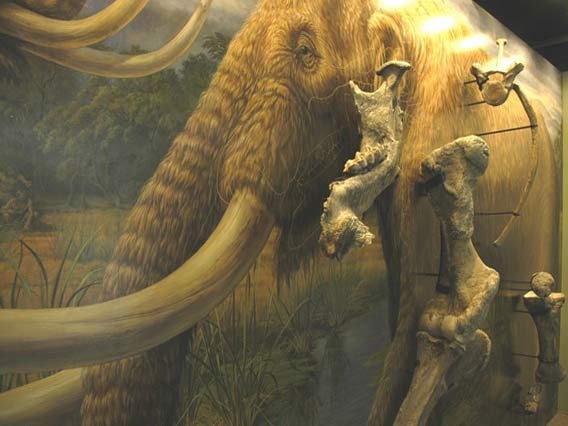
“In the summer of 1977, while operating a backhoe to dig a front yard pond, Sequim resident Emanuel Manis literally uncovered one of the most significant archaeological discoveries in history. There, in his would-be pond, lay the skeletal remains of a mastodon that roamed this area some 14,000 years ago.
In addition to two large mastodon tusks and other bones, the Manis Mastodon site presented archaeologists with direct evidence and momentous clues about the time period. Such finds include several artifacts that suggest the Northern Olympic Peninsula was inhabited by people at least 4,000 years earlier than previously thought and, what’s more, that they hunted mastodons.” (The Museum and Arts Center in the Sequim; Wikipedia)
“The mastodon was dated to be 14,000 years old, not necessarily surprising, but it had a spear point stuck in its ribs.” (Terry Richard, “Manis Mastodon a local celebrity in Dungeness Valley Museum and Arts Center,” OregonLive, 1/31/11)
Marshall Creek Mastodon – 1968
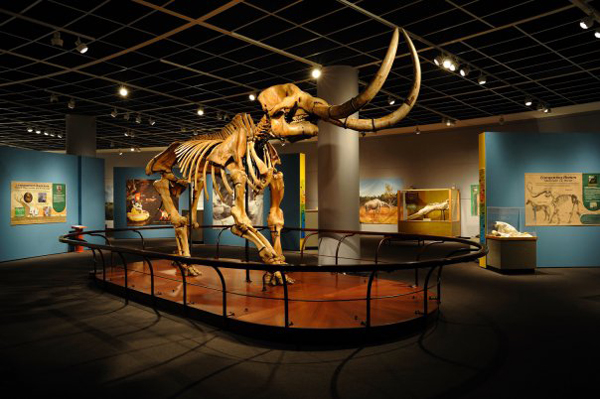
“The Marshalls Creek Mastodon, one of the most significant fossil specimens recovered in the state, will go on permanent public display at The State Museum of Pennsylvania on Feb. 27.
Standing nearly 20 feet long and nine feet high at the shoulders, the nearly complete, 12,000-year-old skeleton will be featured in a new gallery, ‘Life Through Time: a New Paleontology Experience.'” (PRNewswire-USNewswire, HARRISBURG, Pa., 2/2/11; Buy-A-Bone; Mastodon & Friends)
Tualatin Mastodon – 1960’s
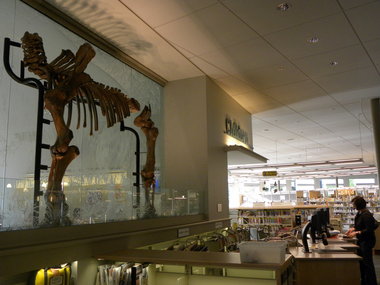
“A mastodon tusk, a giant sloth bone, and 350 feet of water covering Tualatin more than 10,000 years ago.”
(Angela Webber, “Destination: Prehistoric Tualatin?” The Times, 1/13/11)
Tualatin Historical Society
Hallsville – 1909 and 1965
“The skeleton of a great mastodon was dug up in a swamp near Hallsville in 1909. The farm was owned by Hallsville merchant, S. H. Clark. In 1965 another mastodon was discovered on the same farm, then owned by Orval Pontious. Case Institute professor Prufer pronounced the find the most valuable ever made in Ohio.” (DARLENE WEAVER, “Of post offices, mastodons and veterans,” Pickaway Places, Circleville Herald, January 17, 2011)
Conway Mastodon – Newton S. Conway – 1887
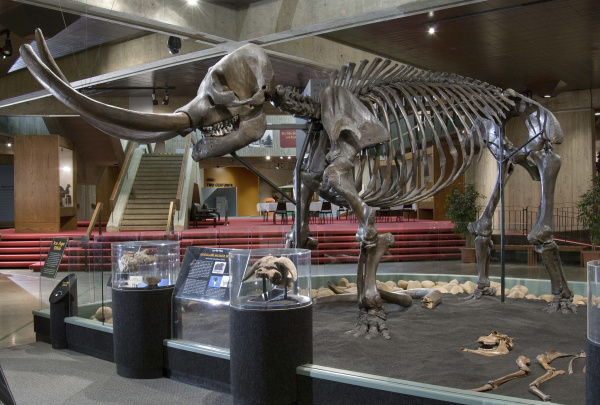
Crawford County – 1837, 1971, 1973

The earliest and most noted mastodon find in Crawford County occurred in 1837, when a complete skeleton was unearthed near Bucyrus. Three other documented mastodon finds were recorded over the years, with the most recent finds in 1971 and 1973. These significant finds of the 1970’s were from the same location on the Brokensword Creek near Sulphur Springs. (“February’s Science Cafe,” The Ohio State University at Marion, 2/1/11)
Thomas Jefferson – 1743 – 1826
“Jefferson did not believe in extinction. He was particularly fascinated by the American mastodon, the elephant relative that he referred to for many years as “the mammoth.” It was not until 1806 in Paris that the French naturalist Georges Cuvier formally separated “mastodonte” from mammoth and also concluded that there were two living species of elephant. But in his Notes on the State of Virginia (1785), Jefferson had already concluded that the cold-adapted “mammoths” were different from the living tropical African and Asian elephants. Over many years he amassed a large collection of “mammoth” remains, which he displayed in the entrance hall of Monticello, his great house in Virginia.” (Keith Thomson, “Jefferson’s Old Bones, Did the so-called father of American vertebrate paleontology believe in fossils?” American Scientist, May-June 2011, Volume 99, Number 3, p. 200)
“With his perceptive analysis of the mastodon and other elephants in Notes on the State of Virginia and his account of Megalonyx, Jefferson made significant contributions to scientific knowledge. He certainly encouraged the discovery and study of fossils by people such as Charles Willson Peale and physician Caspar Wistar (whose own analysis of Megalonyx, published alongside Jefferson’s, was a masterpiece of forensic anatomy). Jefferson was misled by his hopes that the mastodon and Megalonyx were mighty ferocious carnivores that would symbolize American vigor (and contradict European claims of the inferiority of American wildlife), but he was in many ways the progenitor of our modern fascination with another set of monsters from the west—dinosaurs. In these respects, he can fairly be considered a founder of American vertebrate paleontology. But the irony remains that he helped found a discipline without having accepted two of its fundamental premises: fossils and extinction.” (Ibid)
Liberty Science Center

“For tens of thousands of years, humans lived alongside mammoths and mastodons. In eastern North America, people hunted mastodons with spears (and bravery!)
Some scientists think that humans directly caused the extinction of mammoths and mastodons. Others think that climate change was to blame. Whatever the cause, by 12,000 years ago, nearly all mammoths and mastodons had disappeared from North America as well as mainland Eurasia.
Located across the Ohio River from Cincinnati, Big Bone Lick, Kentucky is considered the birthplace of American paleontology. It was here, in the 1700s, that large numbers of Pleistocene fossils were discovered, including mammoth, mastodon, ground sloth and bison. Spear points also found at the site by William Clark in 1807 provided the first evidence that ancient peoples hunted mastodons.
Then in 1979, paleontologists made an exciting discovery at Kimmswick Bone Bed in Imperial, Missouri—stone spear points next to mastodon bones, flint chips from stone sharpening and remnants of campfires. Clearly humans had visited Kimmswick to hunt the herds of animals that came to water at the spring-fed marsh located there.” (Source)
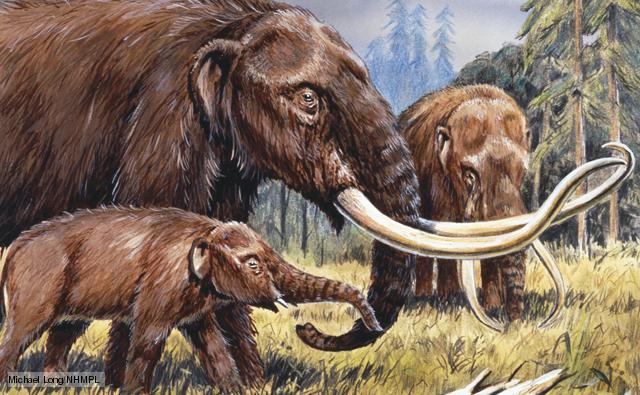
The elephant-like American mastodon was a distant relative of the mammoth, with whom it shared its ice age home. There have been over 200 mastodon fossil finds across North America, but they seem to have been most common along the eastern seaboard and in an area immediately south of the Great Lakes. In 1977, a unique find of a complete mastodon was made in Washington State. A human-made spear point was found embedded in the ribs and further investigation showed that the bones had healed around the spear point. This suggested that humans had attacked this animal, but that it had survived and died much later of old age. (BBC – Wildlife Finder – American Mastodon Facts, Pictures & Stunning Videos)
Mastodon Paleobiology, Taphonomy, and Paleoenvironment in the Late Pleistocene of New York State: Studies on the Hyde Park, Chemung, and North Java Sites
Conclusions: Upper New York State, after the recession of the last ice sheet and during the reign of the mastodon and mammoth, was a boreal environment with a cool, humid climate regime. The tundra environment that immediately followed glacial recession gradually evolved into open forests dominated by spruce, with poplar, paper birch, tamarack, fir and pine present. (“Mastodon Paleobiology, Taphonomy, and Paleoenvironment in the Late Pleistocene of New York State: Studies on the Hyde Park, Chemung, and North Java Sites,” ed. Warren D. Allmon and Peter L. Nester, Palaeontographica Americana, No. 61, July 2008)
A, Dreimanis, “Extinction of Mastodons in Eastern North America: Testing a New Climatic Environmental Hypothesis,” The Ohio Journal of Science, vol. 68, no. 6, Nov. 1968:
Over 600 postglacial mastodons have been reported from the glaciated area south of the Great Lakes, their greatest numbers…and northwestern New York state.

What Mean These Mastodons / Answers in Genesis by Dr. Gary Parker 1/11/11
Peale’s Mastodon:The Skeleton in our Closet by Paul Semonin

Alexander Anderson’s drawing of the “New York Mammoth,” ca. 1802
Additional research available on Research page and to buy at Bookstore.
